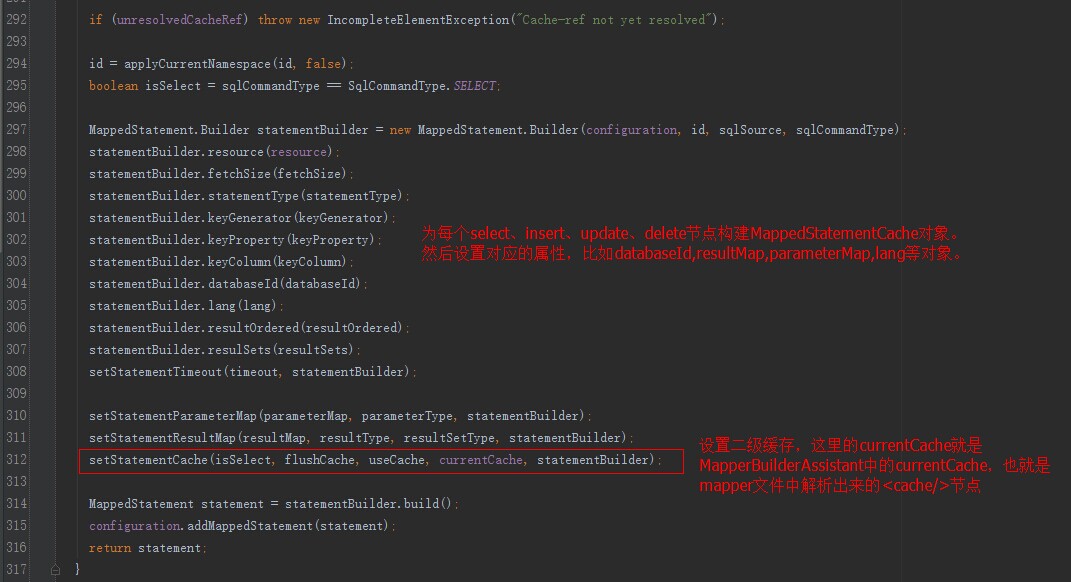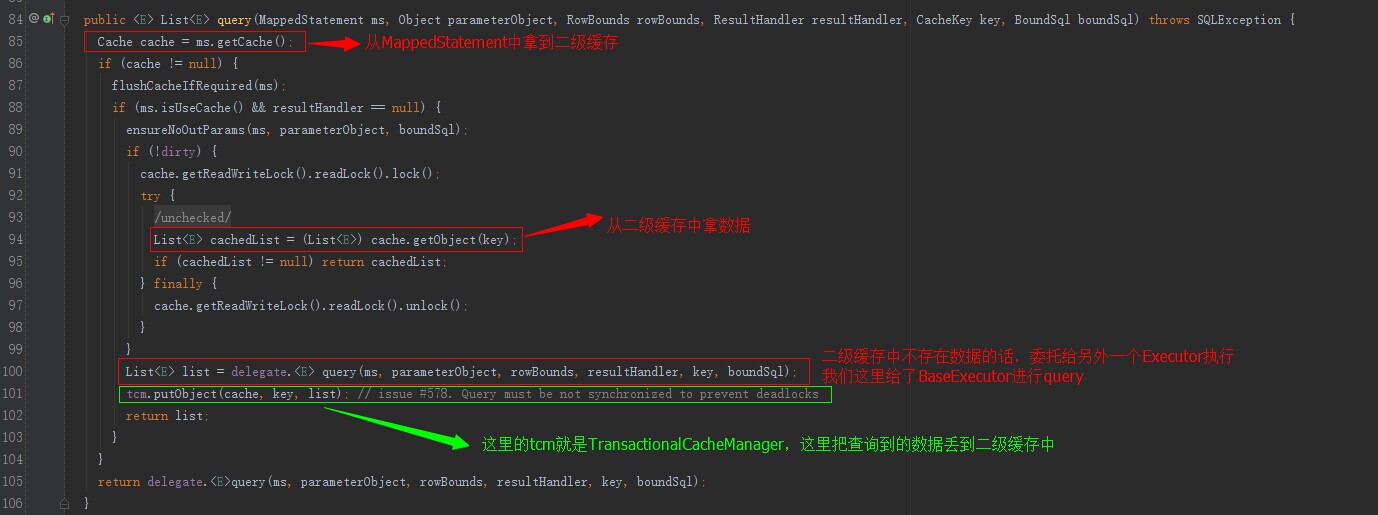前方高能! 本文内容有点多,通过实际测试例子+源码分析的方式解剖MyBatis缓存的概念,对这方面有兴趣的小伙伴请继续看下去~
MyBatis缓存介绍
首先看一段wiki上关于MyBatis缓存的介绍:
MyBatis支持声明式数据缓存(declarative data caching)。当一条SQL语句被标记为“可缓存”后,首次执行它时从数据库获取的所有数据会被存储在一段高速缓存中,今后执行这条语句时就会从高速缓存中读取结果,而不是再次命中数据库。MyBatis提供了默认下基于Java HashMap的缓存实现,以及用于与OSCache、Ehcache、Hazelcast和Memcached连接的默认连接器。MyBatis还提供API供其他缓存实现使用。
重点的那句话就是:MyBatis执行SQL语句之后,这条语句就是被缓存,以后再执行这条语句的时候,会直接从缓存中拿结果,而不是再次执行SQL
这也就是大家常说的MyBatis一级缓存,一级缓存的作用域scope是SqlSession。
MyBatis同时还提供了一种全局作用域global scope的缓存,这也叫做二级缓存,也称作全局缓存。
一级缓存
测试
同个session进行两次相同查询:
1 |
|
MyBatis只进行1次数据库查询:
1 | ==> Preparing: select * from USERS WHERE ID = ? |
同个session进行两次不同的查询:
1 |
|
MyBatis进行两次数据库查询:
1 | ==> Preparing: select * from USERS WHERE ID = ? |
不同session,进行相同查询:
1 |
|
MyBatis进行了两次数据库查询:
1 | ==> Preparing: select * from USERS WHERE ID = ? |
同个session,查询之后更新数据,再次查询相同的语句:
1 |
|
更新操作之后缓存会被清除:
1 | ==> Preparing: select * from USERS WHERE ID = ? |
很明显,结果验证了一级缓存的概念,在同个SqlSession中,查询语句相同的sql会被缓存,但是一旦执行新增或更新或删除操作,缓存就会被清除
源码分析
在分析MyBatis的一级缓存之前,我们先简单看下MyBatis中几个重要的类和接口:
org.apache.ibatis.session.Configuration类:MyBatis全局配置信息类
org.apache.ibatis.session.SqlSessionFactory接口:操作SqlSession的工厂接口,具体的实现类是DefaultSqlSessionFactory
org.apache.ibatis.session.SqlSession接口:执行sql,管理事务的接口,具体的实现类是DefaultSqlSession
org.apache.ibatis.executor.Executor接口:sql执行器,SqlSession执行sql最终是通过该接口实现的,常用的实现类有SimpleExecutor和CachingExecutor,这些实现类都使用了装饰者设计模式
一级缓存的作用域是SqlSession,那么我们就先看一下SqlSession的select过程:
这是DefaultSqlSession(SqlSession接口实现类,MyBatis默认使用这个类)的selectList源码(我们例子上使用的是selectOne方法,调用selectOne方法最终会执行selectList方法):
1 | public <E> List<E> selectList(String statement, Object parameter, RowBounds rowBounds) { |
我们看到SqlSession最终会调用Executor接口的方法。
接下来我们看下DefaultSqlSession中的executor接口属性具体是哪个实现类。
DefaultSqlSession的构造过程(DefaultSqlSessionFactory内部):
1 | private SqlSession openSessionFromDataSource(ExecutorType execType, TransactionIsolationLevel level, boolean autoCommit) { |
我们看到DefaultSqlSessionFactory构造DefaultSqlSession的时候,Executor接口的实现类是由Configuration构造的:
1 | public Executor newExecutor(Transaction transaction, ExecutorType executorType, boolean autoCommit) { |
Executor根据ExecutorType的不同而创建,最常用的是SimpleExecutor,本文的例子也是创建这个实现类。 最后我们发现如果cacheEnabled这个属性为true的话,那么executor会被包一层装饰器,这个装饰器是CachingExecutor。其中cacheEnabled这个属性是mybatis总配置文件中settings节点中cacheEnabled子节点的值,默认就是true,也就是说我们在mybatis总配置文件中不配cacheEnabled的话,它也是默认为打开的。
现在,问题就剩下一个了,CachingExecutor执行sql的时候到底做了什么?
带着这个问题,我们继续走下去(CachingExecutor的query方法):
1 | public <E> List<E> query(MappedStatement ms, Object parameterObject, RowBounds rowBounds, ResultHandler resultHandler, CacheKey key, BoundSql boundSql) throws SQLException { |
其中Cache cache = ms.getCache();这句代码中,这个cache实际上就是个二级缓存,由于我们没有开启二级缓存(二级缓存的内容下面会分析),因此这里执行了最后一句话。这里的delegate也就是SimpleExecutor,SimpleExecutor没有Override父类的query方法,因此最终执行了SimpleExecutor的父类BaseExecutor的query方法。
所以一级缓存最重要的代码就是BaseExecutor的query方法!

BaseExecutor的属性localCache是个PerpetualCache类型的实例,PerpetualCache类是实现了MyBatis的Cache缓存接口的实现类之一,内部有个Map<Object, Object>类型的属性用来存储缓存数据。 这个localCache的类型在BaseExecutor内部是写死的。 这个localCache就是一级缓存!
接下来我们看下为何执行新增或更新或删除操作,一级缓存就会被清除这个问题。
首先MyBatis处理新增或删除的时候,最终都是调用update方法,也就是说新增或者删除操作在MyBatis眼里都是一个更新操作。
我们看下DefaultSqlSession的update方法:
1 | public int update(String statement, Object parameter) { |
很明显,这里调用了CachingExecutor的update方法:
1 | public int update(MappedStatement ms, Object parameterObject) throws SQLException { |
这里的flushCacheIfRequired方法清除的是二级缓存,我们之后会分析。 CachingExecutor委托给了(之前已经分析过)SimpleExecutor的update方法,SimpleExecutor没有Override父类BaseExecutor的update方法,因此我们看BaseExecutor的update方法:
1 | public int update(MappedStatement ms, Object parameter) throws SQLException { |
我们看到了关键的一句代码: clearLocalCache(); 进去看看:
1 | public void clearLocalCache() { |
没错,就是这条,sqlsession没有关闭的话,进行新增、删除、修改操作的话就是清除一级缓存,也就是SqlSession的缓存。
二级缓存
二级缓存的作用域是全局,换句话说,二级缓存已经脱离SqlSession的控制了。
在测试二级缓存之前,我先把结论说一下:
二级缓存的作用域是全局的,二级缓存在SqlSession关闭或提交之后才会生效。
在分析MyBatis的二级缓存之前,我们先简单看下MyBatis中一个关于二级缓存的类(其他相关的类和接口之前已经分析过):
org.apache.ibatis.mapping.MappedStatement:
MappedStatement类在Mybatis框架中用于表示XML文件中一个sql语句节点,即一个<select />、<update />或者<insert />标签。Mybatis框架在初始化阶段会对XML配置文件进行读取,将其中的sql语句节点对象化为一个个MappedStatement对象。
配置
二级缓存跟一级缓存不同,一级缓存不需要配置任何东西,且默认打开。 二级缓存就需要配置一些东西。
本文就说下最简单的配置,在mapper文件上加上这句配置即可:
<cache/>
其实二级缓存跟3个配置有关:
- mybatis全局配置文件中的setting中的cacheEnabled需要为true(默认为true,不设置也行)
- mapper配置文件中需要加入<cache>节点
- mapper配置文件中的select节点需要加上属性useCache需要为true(默认为true,不设置也行)
测试
不同SqlSession,查询相同语句,第一次查询之后commit SqlSession:
1 |
|
MyBatis仅进行了一次数据库查询:
1 | ==> Preparing: select * from USERS WHERE ID = ? |
不同SqlSession,查询相同语句,第一次查询之后close SqlSession:
1 |
|
MyBatis仅进行了一次数据库查询:
1 | ==> Preparing: select * from USERS WHERE ID = ? |
不同SqlSesson,查询相同语句。 第一次查询之后SqlSession不提交:
1 |
|
MyBatis执行了两次数据库查询:
1 | ==> Preparing: select * from USERS WHERE ID = ? |
源码分析
我们从在mapper文件中加入的<cache/>中开始分析源码,关于MyBatis的SQL解析请参考另外一篇博客Mybatis解析动态sql原理分析。接下来我们看下这个cache的解析:
XMLMappedBuilder(解析每个mapper配置文件的解析类,每一个mapper配置都会实例化一个XMLMapperBuilder类)的解析方法:
1 | private void configurationElement(XNode context) { |
我们看到了解析cache的那段代码:
1 | private void cacheElement(XNode context) throws Exception { |
解析完cache标签之后会使用builderAssistant的userNewCache方法,这里的builderAssistant是一个MapperBuilderAssistant类型的帮助类,每个XMLMappedBuilder构造的时候都会实例化这个属性,MapperBuilderAssistant类内部有个Cache类型的currentCache属性,这个属性也就是mapper配置文件中cache节点所代表的值:1
2
3
4
5
6
7
8
9
10
11
12
13
14
15
16
17
18
19
20public Cache useNewCache(Class<? extends Cache> typeClass,
Class<? extends Cache> evictionClass,
Long flushInterval,
Integer size,
boolean readWrite,
Properties props) {
typeClass = valueOrDefault(typeClass, PerpetualCache.class);
evictionClass = valueOrDefault(evictionClass, LruCache.class);
Cache cache = new CacheBuilder(currentNamespace)
.implementation(typeClass)
.addDecorator(evictionClass)
.clearInterval(flushInterval)
.size(size)
.readWrite(readWrite)
.properties(props)
.build();
configuration.addCache(cache);
currentCache = cache;
return cache;
}
ok,现在mapper配置文件中的cache节点被解析到了XMLMapperBuilder实例中的builderAssistant属性中的currentCache值里。
接下来XMLMapperBuilder会解析select节点,解析select节点的时候使用XMLStatementBuilder进行解析(也包括其他insert,update,delete节点):1
2
3
4
5
6
7
8
9
10
11
12
13
14
15
16
17
18
19
20
21
22
23
24
25
26
27
28
29
30
31
32
33
34
35
36
37
38
39
40
41
42
43
44
45
46
47
48
49
50
51
52
53
54
55
56public void parseStatementNode() {
String id = context.getStringAttribute("id");
String databaseId = context.getStringAttribute("databaseId");
if (!databaseIdMatchesCurrent(id, databaseId, this.requiredDatabaseId)) return;
Integer fetchSize = context.getIntAttribute("fetchSize");
Integer timeout = context.getIntAttribute("timeout");
String parameterMap = context.getStringAttribute("parameterMap");
String parameterType = context.getStringAttribute("parameterType");
Class<?> parameterTypeClass = resolveClass(parameterType);
String resultMap = context.getStringAttribute("resultMap");
String resultType = context.getStringAttribute("resultType");
String lang = context.getStringAttribute("lang");
LanguageDriver langDriver = getLanguageDriver(lang);
Class<?> resultTypeClass = resolveClass(resultType);
String resultSetType = context.getStringAttribute("resultSetType");
StatementType statementType = StatementType.valueOf(context.getStringAttribute("statementType", StatementType.PREPARED.toString()));
ResultSetType resultSetTypeEnum = resolveResultSetType(resultSetType);
String nodeName = context.getNode().getNodeName();
SqlCommandType sqlCommandType = SqlCommandType.valueOf(nodeName.toUpperCase(Locale.ENGLISH));
boolean isSelect = sqlCommandType == SqlCommandType.SELECT;
boolean flushCache = context.getBooleanAttribute("flushCache", !isSelect);
boolean useCache = context.getBooleanAttribute("useCache", isSelect);
boolean resultOrdered = context.getBooleanAttribute("resultOrdered", false);
// Include Fragments before parsing
XMLIncludeTransformer includeParser = new XMLIncludeTransformer(configuration, builderAssistant);
includeParser.applyIncludes(context.getNode());
// Parse selectKey after includes and remove them.
processSelectKeyNodes(id, parameterTypeClass, langDriver);
// Parse the SQL (pre: <selectKey> and <include> were parsed and removed)
SqlSource sqlSource = langDriver.createSqlSource(configuration, context, parameterTypeClass);
String resultSets = context.getStringAttribute("resultSets");
String keyProperty = context.getStringAttribute("keyProperty");
String keyColumn = context.getStringAttribute("keyColumn");
KeyGenerator keyGenerator;
String keyStatementId = id + SelectKeyGenerator.SELECT_KEY_SUFFIX;
keyStatementId = builderAssistant.applyCurrentNamespace(keyStatementId, true);
if (configuration.hasKeyGenerator(keyStatementId)) {
keyGenerator = configuration.getKeyGenerator(keyStatementId);
} else {
keyGenerator = context.getBooleanAttribute("useGeneratedKeys",
configuration.isUseGeneratedKeys() && SqlCommandType.INSERT.equals(sqlCommandType))
? new Jdbc3KeyGenerator() : new NoKeyGenerator();
}
builderAssistant.addMappedStatement(id, sqlSource, statementType, sqlCommandType,
fetchSize, timeout, parameterMap, parameterTypeClass, resultMap, resultTypeClass,
resultSetTypeEnum, flushCache, useCache, resultOrdered,
keyGenerator, keyProperty, keyColumn, databaseId, langDriver, resultSets);
}
这段代码前面都是解析一些标签的属性,我们看到了最后一行使用builderAssistant添加MappedStatement,其中builderAssistant属性是构造XMLStatementBuilder的时候通过XMLMappedBuilder传入的,我们继续看builderAssistant的addMappedStatement方法:

进入setStatementCache:
1 | private void setStatementCache( |
最终mapper配置文件中的<cache/>被设置到了XMLMapperBuilder的builderAssistant属性中,XMLMapperBuilder中使用XMLStatementBuilder遍历CRUD节点,遍历CRUD节点的时候将这个cache节点设置到这些CRUD节点中,这个cache就是所谓的二级缓存!
接下来我们回过头来看查询的源码,CachingExecutor的query方法:

进入TransactionalCacheManager的putObject方法:1
2
3
4
5
6
7
8
9
10
11
12
13public void putObject(Cache cache, CacheKey key, Object value) {
getTransactionalCache(cache).putObject(key, value);
}
private TransactionalCache getTransactionalCache(Cache cache) {
TransactionalCache txCache = transactionalCaches.get(cache);
if (txCache == null) {
txCache = new TransactionalCache(cache);
transactionalCaches.put(cache, txCache);
}
return txCache;
}
TransactionalCache的putObject方法:1
2
3
4public void putObject(Object key, Object object) {
entriesToRemoveOnCommit.remove(key);
entriesToAddOnCommit.put(key, new AddEntry(delegate, key, object));
}
我们看到,数据被加入到了entriesToAddOnCommit中,这个entriesToAddOnCommit是什么东西呢,它是TransactionalCache的一个Map属性:1
private Map<Object, AddEntry> entriesToAddOnCommit;
AddEntry是TransactionalCache内部的一个类:1
2
3
4
5
6
7
8
9
10
11
12
13
14
15private static class AddEntry {
private Cache cache;
private Object key;
private Object value;
public AddEntry(Cache cache, Object key, Object value) {
this.cache = cache;
this.key = key;
this.value = value;
}
public void commit() {
cache.putObject(key, value);
}
}
好了,现在我们发现使用二级缓存之后:查询数据的话,先从二级缓存中拿数据,如果没有的话,去一级缓存中拿,一级缓存也没有的话再查询数据库。有了数据之后在丢到TransactionalCache这个对象的entriesToAddOnCommit属性中。
接下来我们来验证为什么SqlSession commit或close之后,二级缓存才会生效这个问题。
DefaultSqlSession的commit方法:1
2
3
4
5
6
7
8
9
10public void commit(boolean force) {
try {
executor.commit(isCommitOrRollbackRequired(force));
dirty = false;
} catch (Exception e) {
throw ExceptionFactory.wrapException("Error committing transaction. Cause: " + e, e);
} finally {
ErrorContext.instance().reset();
}
}
CachingExecutor的commit方法:1
2
3
4
5public void commit(boolean required) throws SQLException {
delegate.commit(required);
tcm.commit();
dirty = false;
}
tcm.commit即 TransactionalCacheManager的commit方法:1
2
3
4
5public void commit() {
for (TransactionalCache txCache : transactionalCaches.values()) {
txCache.commit();
}
}
TransactionalCache的commit方法:1
2
3
4
5
6
7
8
9
10
11
12
13
14
15
16
17
18public void commit() {
delegate.getReadWriteLock().writeLock().lock();
try {
if (clearOnCommit) {
delegate.clear();
} else {
for (RemoveEntry entry : entriesToRemoveOnCommit.values()) {
entry.commit();
}
}
for (AddEntry entry : entriesToAddOnCommit.values()) {
entry.commit();
}
reset();
} finally {
delegate.getReadWriteLock().writeLock().unlock();
}
}
发现调用了AddEntry的commit方法:1
2
3public void commit() {
cache.putObject(key, value);
}
发现了! AddEntry的commit方法会把数据丢到cache中,也就是丢到二级缓存中!
关于为何调用close方法后,二级缓存才会生效,因为close方法内部会调用commit方法。本文就不具体说了。 读者有兴趣的话看一看源码就知道为什么了。
其他
Cache接口简介
org.apache.ibatis.cache.Cache是MyBatis的缓存接口,想要实现自定义的缓存需要实现这个接口。
MyBatis中关于Cache接口的实现类也使用了装饰者设计模式。
我们看下它的一些实现类:

简单说明:
LRU – 最近最少使用的:移除最长时间不被使用的对象。
FIFO – 先进先出:按对象进入缓存的顺序来移除它们。
SOFT – 软引用:移除基于垃圾回收器状态和软引用规则的对象。
WEAK – 弱引用:更积极地移除基于垃圾收集器状态和弱引用规则的对象。1
2
3
4
5<cache
eviction="FIFO"
flushInterval="60000"
size="512"
readOnly="true"/>
可以通过cache节点的eviction属性设置,也可以设置其他的属性。
cache-ref节点
mapper配置文件中还可以加入cache-ref节点,它有个属性namespace。
如果每个mapper文件都是用cache-ref,且namespace都一样,那么就代表着真正意义上的全局缓存。
如果只用了cache节点,那仅代表这个这个mapper内部的查询被缓存了,其他mapper文件的不起作用,这并不是所谓的全局缓存。
总结
总体来说,MyBatis的源码看起来还是比较轻松的,本文从实践和源码方面深入分析了MyBatis的缓存原理,希望对读者有帮助。

